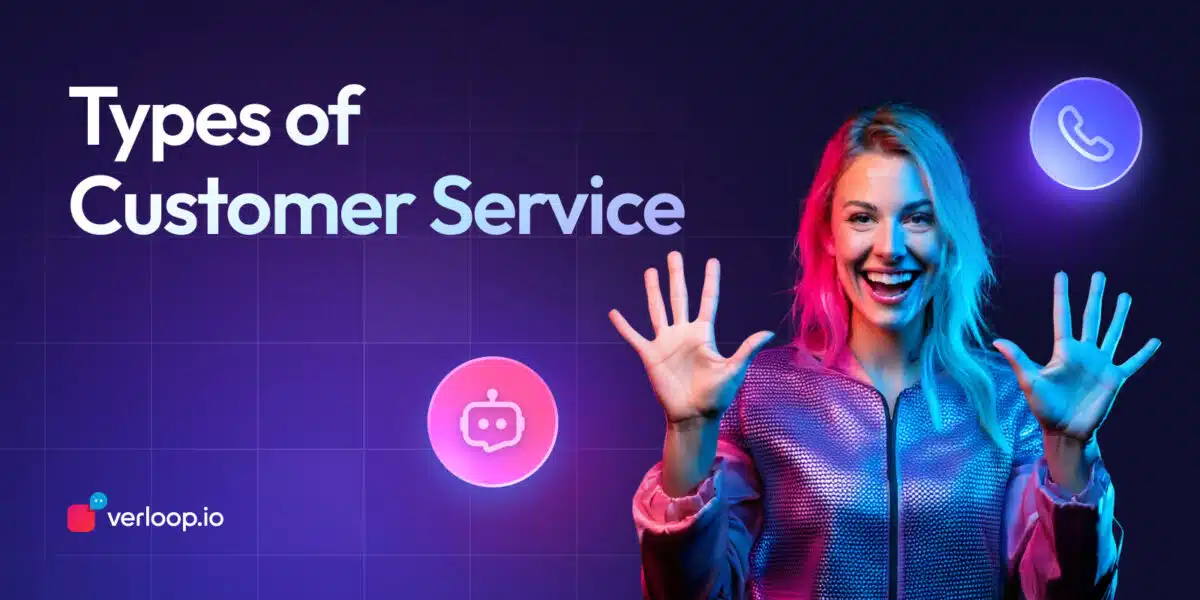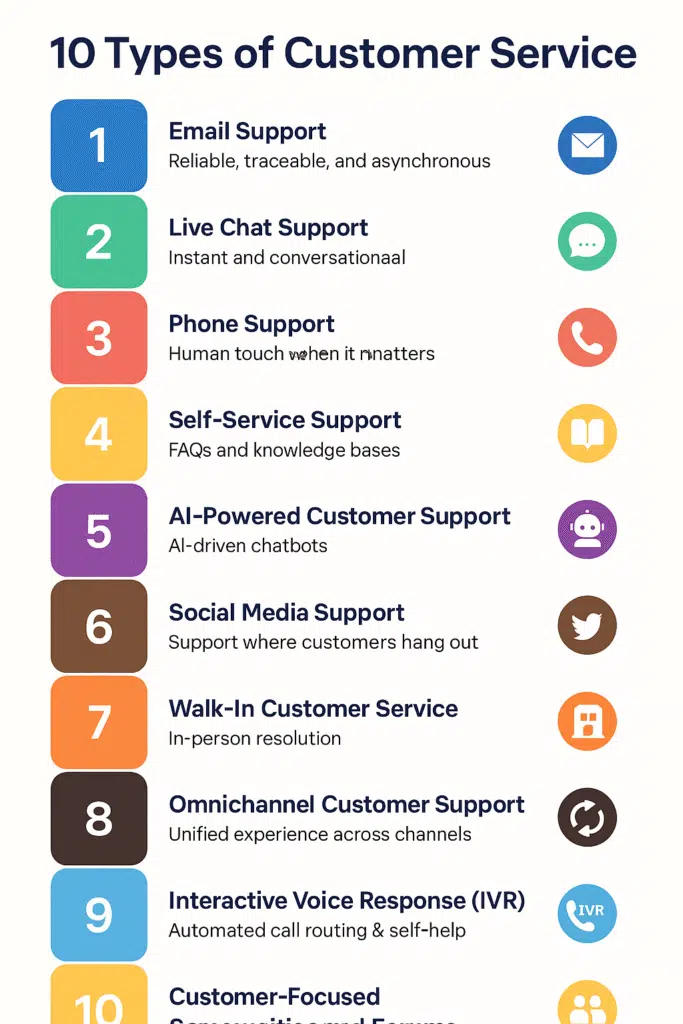
10 Types of Customer Service in 2025
- July 10th, 2025 / 14 Mins read
-
Aarti Nair
We look at different types of customer support and how to go about selecting the best option for your company.
One way to keep your customers happy is by establishing a well-organised customer support system in your business. As per a report by Statista, the main priority of delivering customer support is to improve customer satisfaction by more than 50%. Customer service is an ever-changing sector, so you must be up to date with the latest developments in this field. There are various types of customer support solutions a company can choose from.
The customer support portal system has been evolving for a long time. Every upcoming brand aims to be consumer-centric, claiming to care more about their customers than making profits.
A solid proof of a company’s interest in its consumers is the quality of its customer service. But what is customer service, and why is it such a big deal? First, let us answer this query.
Consumers are responsible for defining the brand and keeping businesses afloat, so it is crucial to give them what they want. Customer support does just that by answering queries and offering the best experience to people.
Happy and satisfied customers are the main ingredient for a successful business.
One loyal customer will indirectly market and promote your brand to other people. Similarly, an unhappy customer expressing dissatisfaction with your brand will drive potential leads away, affecting your business negatively.
This blog aims to familiarise readers with all the customer support types and aid in selecting the ideal one.
What is Customer Service?
Let’s cut to the chase:
Your product can be best-in-class, your pricing unbeatable, but if a customer runs into a problem and doesn’t get timely, helpful support?
You’ve lost more than just a sale!
You’ve likely lost long-term trust.
Customer service is the operational backbone of customer experience. It’s the process of supporting your users across channels—when they have questions, hit roadblocks, or simply need guidance. And in a world of rising expectations and instant gratification, it’s no longer optional.
📊 According to Microsoft, 90% of customers consider service a deciding factor when choosing a brand.
💡 HubSpot reports that 93% of customers are more likely to stay loyal to companies with excellent service.
For businesses, that means support is not just a cost centre but it’s a revenue enabler.
But customer service today is more complex than manning a phone line.
It includes:
-
Answering product questions via chat
-
Troubleshooting bugs over email
-
Offering self-service FAQs
-
Automating responses through AI agents
-
Providing in-person onboarding or field support
And that’s where many companies fall short, not because they don’t have a support function, but because they rely on one-dimensional service models that don’t scale with customer needs.
So the real question is:
Are you offering the right kind of service for the right kind of customer?
In the next section, we’ll explore the 10 types of customer service businesses can adopt, along with use cases to help you identify what aligns best with your support goals. But first, let’s deep dive into why customer service is important.
Why is Customer Service Important?
Think of customer service as the front line of your brand. It’s where loyalty is either earned or lost in real time.
Businesses are no longer just evaluated on product features or pricing. Customers are evaluating the experience of doing business with you. And that experience is shaped largely by how you respond when something goes wrong.
Here’s why customer service isn’t just important and why it’s business-critical:
1. It Directly Impacts Revenue
Poor service doesn’t just lead to churn—it also blocks future revenue. A delayed refund, an unresolved ticket, or an unanswered query can stop a customer from renewing, upgrading, or even referring others.
Conversely, exceptional service increases the chances of repeat business, word-of-mouth referrals, and higher customer lifetime value.
2. It Influences Brand Perception
Your marketing may promise “delightful experiences,”—but if support fails to deliver, that promise falls apart. Customer service is often the only human touchpoint post-sale, and it’s where brand credibility is reinforced (or undone).
3. It’s a Competitive Differentiator
When products and pricing are increasingly similar across markets, service becomes your edge. A business that responds in minutes, not hours—and resolves, not deflects—stands out, builds trust, and becomes harder to replace.
4. It Fuels Product Improvement
Customer service is a goldmine of insights. Support teams often hear about bugs, friction points, and unmet needs long before product teams do. If you’re listening carefully, support can directly inform roadmap decisions and improve retention.
5. It Drives Operational Efficiency
Well-structured customer service—through automation, AI agents, and intelligent routing—reduces overhead, shortens resolution time, and frees up human agents to focus on high-impact interactions.
In short, customer service isn’t just about solving problems.
It’s about retaining customers, protecting brand value, and accelerating growth.
Next, let’s break down the 10 types of customer service models businesses are using today—and which ones might fit your growth stage.
10 Types of Customer Service
As the term suggests, customer service focuses on assisting those customers who are either using or planning to use a company’s product or services.
Hence, a business must first understand the needs of its customers before anything else. A need in the business world is either related to the product or service.
A service need is where the customer support department plays its part.
People are always hunting for new products, information, and answers. The customer support department is responsible for providing solutions to customer queries.
The support teams must empathise with the customers and establish transparency because it improves consumer satisfaction.
Now we are familiar with the basic ideas of customer service. Let us delve into the various types of customer service.
1. Email Support
Best for:
Non-urgent queries, technical troubleshooting, escalations, or when documentation and clarity are important.
Email remains one of the most widely used and trusted customer support channels, especially in B2B and high-consideration industries. Why?
Because it gives both the customer and the business the space to communicate clearly, attach context, and track the conversation over time.
Unlike live chat or calls, emails allow for more thoughtful responses, which is critical when resolving:
-
Step-by-step troubleshooting
-
Billing disputes
-
Product customisation queries
-
Policy clarifications
-
Service-level agreement (SLA) issues
And since email threads are automatically documented, they become part of the customer’s support history, which is helpful for follow-ups, audits, or hand-offs between support tiers.
Why Email Support Still Matters
-
Asynchronous: Customers don’t have to wait online. They send a query and get a reply when it’s ready.
-
Scalable: Easily routed, queued, and assigned across teams.
-
Trackable: Every message has a timestamp, history, and reference ID, which are crucial for SLA compliance.
-
Integrated: Works well with helpdesk platforms like Zendesk, Freshdesk, and Salesforce Service Cloud.
-
Professional tone: Preferred for formal communication, especially in enterprise and regulated sectors.
Suggested Reading: Email vs Conversational AI Support
2. Live Chat Support
Best for:
💬 Real-time assistance during web or app sessions, when speed, context, and convenience matter most.
Live chat has become the go-to channel for customers who need immediate help, without the friction of switching platforms, calling a number, or drafting an email.
Whether it’s a product query, pricing clarification, or troubleshooting a login issue, live chat offers a low-effort, high-speed support experience. And it’s increasingly the default expectation, especially for digital-first businesses.
The numbers speak for themselves:
-
The live chat software market was valued at $1.1 billion in 2024, and is projected to reach $2.17 billion by 2033.
-
63% of customers already use live chat to reach out to businesses.
-
60% of users say they’re more likely to return to a website that offers live chat.
Live chat support typically appears as a widget on your website or app. Customers type in their question and receive a reply within seconds—either from:
-
A human agent
-
An AI chatbot
-
Or a hybrid setup with smart routing based on query type or agent availability
Modern platforms like Verloop.io also offer CRM and helpdesk integrations, meaning your agents see the full context of the customer’s journey: what they clicked, what they asked last time, and what stage they’re at in the funnel.
Suggested Reading: Live Chat vs Conversational AI Support
Benefits of Live Chat for Businesses:
-
Higher conversion rates (especially during checkout and product pages)
-
Real-time ticket resolution before issues escalate
-
Lower operational cost compared to phone support
-
Always-on support when paired with AI chatbots
-
Improved agent efficiency via canned responses, auto-tagging, and CRM context
3. Phone Support
Best for:
High-stakes, emotionally sensitive, or complex issues where empathy, urgency, or explanation are key.
For all the automation in today’s support stack, sometimes, what a customer really needs is a human voice on the other end of the line.
Phone support plays a crucial role when the stakes are high—whether it’s resolving a payment failure, walking through an account breach, or addressing a health-related concern. In such scenarios, tone, pacing, empathy, and reassurance can make the difference between a frustrated customer and a retained one.
Why Phone Support Still Matters
-
Human connection: A reassuring tone goes further than a templated response
-
Faster resolution for complex queries: Easier to explain or clarify in conversation
-
Builds trust: Especially in sensitive, high-value, or regulated industries
-
Escalation path: Gives customers a direct channel when chat or email fall short
-
Empathetic handling: Critical during complaints, refunds, or high-emotion moments.
Suggested Reading: Phone vs Conversational AI Support
4. Self-Service Support (FAQs & Knowledge Bases)
Best for:
Reducing ticket load, improving resolution speed, and empowering users to solve problems independently.
Sometimes, the best support interaction… is no interaction at all.
In fact, your customers often prefer it that way.
Self-service support gives users instant access to the answers they need, without having to wait for an agent. Think: searchable FAQ pages, help articles, video tutorials, troubleshooting guides, and AI-powered knowledge bases.
It’s support that scales, saves time, and reduces agent load, especially for repeatable, low-complexity queries.
Our research shows that 61% of customers prefer self-service for resolving simple issues like password resets, pricing clarification, or tracking an order.
Customers today are more tech-savvy and time-conscious. They expect businesses to offer support options that don’t involve queues, call drops, or explaining the same issue twice.
For businesses, a well-built self-service portal can:
-
Deflect hundreds (or thousands) of tickets per month
-
Free up agents to focus on higher-value interactions
-
Create consistent, approved responses
-
Serve global users, 24/7, without added headcount
Benefits of Self Service for Businesses
-
Cost-effective: One guide can serve thousands
-
Scalable: No limit to how many users can access it simultaneously
-
Consistent: Customers get standardised information
-
Improves CSAT: Users feel empowered when they solve issues themselves
-
Reduces first-response time: Especially when integrated with AI bots that surface relevant help articles in live chat
5. AI-Powered Customer Support (Chatbots)
Best for:
Handling repetitive, high-volume queries with speed, consistency, and minimal human effort.
As your business grows, so do support requests but not all of them require human intervention. Many are simple, repetitive, and predictable:
“Where’s my order?”, “How do I reset my password?”, “Is this product in stock?”
This is where AI-powered chatbots shine.
Built to mimic human conversation (but without the fatigue or training gaps), modern AI bots, like those on Verloop.io can:
-
Understand natural language
-
Pull data from your backend systems (CRMs, order management, etc.)
-
Handle 80%+ of routine queries without escalation
-
Route complex issues to agents with full context
-
Work across platforms: website, WhatsApp, Facebook Messenger, mobile app
Why Businesses Love AI Chatbots
-
24/7 availability: No breaks, no queues
-
Scalable: Whether you have 10 or 10,000 chats per day
-
Faster resolution = improved CSAT
-
Reduced support cost
-
Consistent tone and policy adherence
6. Customer support via social media
Best for:
Boosting brand credibility, responding in public view, and managing modern customer touchpoints.
Social media has taken the internet by storm and will expand in the coming years. Social media platforms used to be a place dominated by children and young adults until the world realised their utility as far as marketing and outreach are concerned.
Now it is a business haven, so clearly it can offer customer support. Some platforms such as Facebook enable users to leave business reviews, making it seem like a commercial space.
However, customer support via social media is not an easy feat.
Customers take their support issues to social media to get a faster response. This is a tricky situation because if you don’t solve the query quickly and accurately, it can negatively impact your company.
You will have to keep an eye on all your social media platforms to deal with queries because they may present them through comments, direct messages, or even alternate posts.
A business needs to establish monitoring software for all the sites. These social media listening platforms notify your team whenever your brand is mentioned in any message over any of the channels.
However, no matter how good your monitoring software is, you will likely miss some complaints. And again, you need to hire and train a team of agents who would be dedicatedly to managing such queries on your social media sites.
Social media isn’t just for marketing, it’s an active customer support channel, whether you’re ready for it or not.
Customers now take to Twitter, Instagram, Facebook, and even LinkedIn to ask questions, raise issues, or request updates. And unlike private channels, the interaction is public—which makes timely, thoughtful responses even more critical.
A visible and responsive social support presence:
-
Boosts customer trust
-
Shows you’re listening
-
Helps contain negative sentiment
-
Turns public problems into public wins
Benefits of Social Support
-
Real-time engagement
-
Reputation management in public view
-
Faster escalations through direct messaging
-
Connects support with marketing for unified CX
-
Great for Gen Z & Millennial users, who expect instant responses where they already are
7. Walk-in Customer Service Departments
Best for:
In-person troubleshooting, identity verification, or regulated service workflows in industries like banking, telecom, healthcare, and retail.
While digital support is on the rise, some problems still need to be solved face-to-face.
That’s where walk-in customer service centres remain indispensable.
These physical branches are designed to handle situations where:
-
Customers need to submit documents in person
-
Hardware or product inspection is required
-
KYC (Know Your Customer) processes or biometrics are involved
-
On-the-spot resolution builds greater trust
And while many businesses are shifting to digital-first models, in-person service still plays a vital role in customer retention and operational trust, especially in regions where digital literacy or infrastructure is still catching up.
Why Businesses Still Invest in Physical Support
-
Critical for identity-driven sectors (banking, telco, insurance)
-
Higher trust in face-to-face support
-
Essential for hardware diagnostics or fulfilment
-
Localised service hubs that reduce dependency on central teams
8. Omnichannel Customer Support
Best for:
Businesses managing high interaction volumes across WhatsApp, chat, email, phone, and social—and want to avoid fragmented experiences.
Today’s customers don’t think in terms of “channels.” They just want help, wherever they are.
Whether they raise a query via WhatsApp, follow up by email, or finally escalate through a phone call, they expect continuity. That’s what omnichannel support delivers.
An omnichannel support system unifies all customer touchpoints into a single, integrated view. Agents can track the entire interaction journey across platforms, without the customer needing to repeat themselves.
Why Omnichannel Support Is a Game-Changer
-
Consistent CX across all channels
-
Fewer handoffs, faster resolutions
-
Unified agent dashboards for better productivity
-
Cross-channel insights into customer behaviour and bottlenecks
-
Higher NPS and retention—because customers don’t have to repeat themselves
9. Interactive voice response (IVR) system
Best for:
Automatically routing inbound calls, delivering account updates, or handling repetitive queries without human intervention.
IVR is a type of customer service utilising a telephony system to interact with customers.
It is an old-school method, but it is effective enough to still be in use today. IVR can achieve great results for small businesses and startups that cannot afford modern customer service solutions.
Interactive Voice Response (IVR) system is an automated system that directs your customers to the ideal department. It operates via a dial pad, keypad, and voice recognition systems.
If you have ever come across a dialogue beginning with “press 1 for…”, then you have had the first-hand experience of dealing with IVR customer support.
This method is tedious and futile for large businesses because the menus in IVR are too complex. However, a well-organized IVR system can do wonders for the customer service department in your company.
IVR is effective if you plan on dividing the customer service department into small sections, each responsible for handling different types of questions. It is effective because a single agent is not knowledgeable enough to tackle every query.
One drawback of IVR is that it cannot manage the high volume of calls or an exceptional query.
The IVR has a reputation for losing customers due to the long wait when handling too many customers. Remember that another person is waiting in line each time you are tending to one customer.
Before a live agent ever picks up the phone, IVR steps in as the first line of automation in many contact centres.
IVR (Interactive Voice Response) systems allow customers to navigate support options using voice prompts or keypad inputs. It’s efficient, scalable, and ideal for high-volume call environments.
With a well-designed IVR flow, you can:
-
Route calls based on intent (“Press 1 for payments, Press 2 for technical support…”)
-
Share self-service updates (order status, account balance, payment due)
-
Collect pre-call inputs to reduce agent handle time
-
Prioritise or triage high-value customers
Why Businesses Use IVR?
-
Reduces call centre load
-
Improves first-call resolution by routing to the right agent
-
Available 24/7 even outside agent working hours
-
Cuts operational costs without sacrificing availability
-
Scales effortlessly across time zones and regions
Suggested Reading: IVR vs Conversational AI Support
10. Customer Communities & Forums
Best for:
Encouraging peer-to-peer problem-solving, reducing support load, and building brand loyalty.
Support doesn’t always have to come from your team. Sometimes, your best resource is your own user base.
Customer communities and forums give users a space to ask questions, share solutions, and troubleshoot issues collaboratively. These platforms foster engagement, advocacy, and even innovation—especially in industries where usage scenarios vary widely.
SaaS companies, developer tools, edtech platforms, and consumer tech brands often benefit the most.
Why Businesses Should Build Communities
-
Deflects support tickets by enabling peer responses
-
Drives product education through real user examples
-
Creates feedback loops between customers and product teams
-
Fosters brand advocates and power users
-
Improves SEO with publicly searchable answers.
Each service type solves a different need. The most efficient support strategies?
They combine multiple types—backed by automation, unified data, and a clear understanding of the customer journey.
In the next section, let’s explore how to choose the right mix of service types based on your business size, industry, and support objectives.
Suggested Reading: The Ultimate Guide to Conversational AI: How it Works, Use Cases, Examples, Challenges
How to select the best customer support type for your business?
It is not easy to select a single mode of consumer support when there are so many options available in the market.
Your choice should depend on the stage of business, customer preference and its current success. There are other factors worth consideration while picking the methods of customer support. It will enable customers from all regions to find your company satisfactory.
Even though your decision must be a judgement call, two types of customer support guarantee success every time.
Omnichannel customer support
These days, potential customers are scattered all over the internet. It includes all the social media sites, commercial platforms, and everything in between. As a business, it is crucial to expand one’s reach as much as possible.
The possibility of missing out on any customer query creates the need for an omnichannel customer service system.
The idea behind such an arrangement is the concern that some people might want to reach out to you via different modes, including offline platforms.
Some people do not bother to get in touch if your customer service channel is not present on their desired platform. Hence, settling with a single means of customer support is asking for loss in the 21st century.
A study conducted by Dimensional Research mentioned that 28% of customers reported that having alternatives for communication allow for a better consumer experience. 27% of the participants said that the lack of a customer service option on their preferred channel resulted in a bad experience.
This study is proof that omnichannel services should get adopted by businesses aiming to satisfy their customers. Several other types of research are coming to the same results and speculations. Thus, make sure that you aim high when opening a customer service department.
Omnichannel services also point towards establishing offline channels, so old-school options such as IVR are not out the window. It is ideal to adapt to new technology, but integrating new with old is innovative and inclusive.
What’s important is that your customer support method meets your customer’s preference. For this, you need to identify what your customers want and how you can serve them better.
At the end of the day, providing excellent customer service is the goal.
In short, modern methods such as chatbots could be coupled with more traditional types of customer service to ensure the best outcomes. Place a self-service option along with an easy way to reach your customer service representatives, and your fanbase will have all its queries answered accurately on time.
In single-channel customer service, a large crowd will feel excluded. Remember that your company will appear more inclusive, empathetic, and modern if there are alternatives for customer service.
React and approach
A business must decide its style of interacting with its customers, which is either passive or active. Traditionally, the customer service sector has been cold, acting only when a customer approached a company to resolve an issue.
The only function of customer service was answering people, but this approach has to change in today’s world. Brands go to great lengths to market their products. A business must adopt an active (in other words, proactive) approach to tackle this competition.
Never wait for customers to approach you, so reach out and interact with them.
Now you may ask why proactive customer support is important? Because, this approach to customer support shows that a company cares about its customers.
How to Choose the Right Mix of Customer Service Types?
Based on your business size, industry, and support objectives
Offering every type of customer service sounds ideal—but it’s rarely practical or cost-effective. The real advantage lies in identifying the right combination of support channels that serve your customers well without draining your resources.
So how do you decide what’s right for your business?
Let’s break it down by key factors:
1. Business Size & Stage
-
Early-stage / Small Teams:
Focus on email, live chat, and self-service. These are cost-effective, manageable with fewer agents, and can cover most common queries. -
Mid-sized / Scaling Teams:
Introduce AI chatbots, IVR, and basic omnichannel tools. This helps you automate first responses and reduce repetitive workload without hiring aggressively. -
Enterprise / High-volume Businesses:
Invest in a full-stack setup, omnichannel platforms, voice support, AI agents, and community forums. At this scale, coverage and consistency matter more than simplicity.
2. Industry Expectations
Different industries have different customer service norms. Here’s how it typically plays out:
| Industry | Recommended Service Types |
|---|---|
| Retail / D2C | Live chat, WhatsApp, self-service, AI chatbots |
| BFSI | IVR, phone support, walk-in centres, secure email |
| SaaS / Tech | Email, AI support, community forums, knowledge bases |
| Healthcare | Phone support, walk-in centres, appointment scheduling via chat |
| Travel / Logistics | IVR, social media, live chat, omnichannel support |
Customers expect support to match their urgency and comfort level. A B2B SaaS buyer may prefer documentation and email; a retail shopper may expect live chat within 3 seconds.
3. Support Objectives
Your customer service strategy should reflect your business goals.
-
Want to reduce ticket volume? → Invest in self-service and AI automation
-
Looking to improve CSAT or NPS? → Strengthen phone and live chat with context
-
Trying to scale globally? → Prioritise 24/7 bot support, knowledge bases, and multilingual options
-
Need to offer VIP handling? → Introduce dedicated phone lines or premium queues
You don’t need every type of support.
You need the right mix that aligns with what your customers expect—and what your team can deliver efficiently.
Start with what your customers use most. Add automation where it creates value. Then scale thoughtfully with the right tools, training, and data integration.
Conclusion
As we mentioned before, potential customers are everywhere, and there are many types of customer support you can provide.
Customer service can open several opportunities for business growth, provided it gets executed the right way. Selecting the ideal types of customer service for your business has to do with scale, budget and customer preference.
Verloop.io is the leading provider of conversational AI customer support. Our AI is trained on 2 billion customer queries to ensure the AI accurately understands the intent behind the customer’s question and answers them quickly and on their preferred channel.
Talk to our experts and get a demo of our platform.

Frequently Asked Questions (FAQs)
1. What’s the difference between multichannel and omnichannel customer support?
Multichannel means you’re present on multiple platforms (e.g. email, phone, chat), but they may not be integrated. Omnichannel support connects those platforms, allowing agents and customers to move between channels seamlessly, without losing context or conversation history.
2. How many customer service channels should a business have?
It depends on your business size, customer preferences, and operational capacity. Most businesses start with 2–3 core channels (like email, live chat, and self-service), and expand based on demand. The goal isn’t to be everywhere—it’s to be effective where it matters.
3. What are the most scalable types of customer service?
The most scalable options include AI-powered chatbots, knowledge bases, and automated IVR systems. These handle high volumes without increasing headcount and work 24/7 across time zones.
4. Is phone support still necessary in the age of AI and chatbots?
Yes—for certain industries and scenarios. Phone support is still essential for complex, emotional, or regulated interactions (e.g. BFSI, healthcare, enterprise SaaS). AI can handle routine queries, but phone ensures human empathy where it’s needed most.
5. How do I decide if I need a chatbot for customer service?
If your team is overloaded with repetitive questions (e.g. “Where’s my order?” or “How do I reset my password?”), a chatbot can help. Tools like Verloop.io allow you to automate these interactions, reduce resolution time, and cut support costs.
6. What kind of support do B2B companies need compared to B2C?
B2B support usually involves longer sales cycles, detailed onboarding, and technical troubleshooting. Email, live chat, account-based phone support, and documentation are key. B2C often leans more on speed and convenience through chatbots, social media, and IVR.
7. What are the best tools to manage multiple support channels efficiently?
Look for platforms that offer omnichannel capabilities, like Verloop.io, Zendesk, Freshdesk, or Salesforce Service Cloud. These tools let your agents manage conversations across email, chat, voice, and social—from a single unified dashboard.








